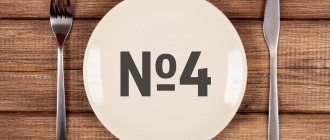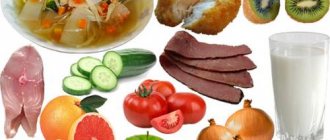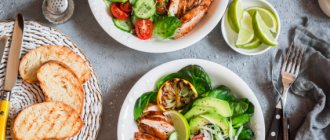According to the World Health Organization for 2021, 4 out of 10 adults in the world are overweight, which makes this problem extremely urgent. To solve this problem, nutritionists prescribe diets that take into account the individual condition of the patient, his age, chronic pathologies and much more. Specialized diets for patients with cardiovascular diseases also have a positive effect on the patient’s weight. The diet and set of products in such diets are ideal for losing weight.
Heart diet
Various cardiac diets are medically called cardiotrophic nutrition. This means that such a diet:
- first of all, it reduces the symptoms and slows down the progression of cardiac pathologies in sick people;
- secondly, it significantly reduces the risk of cardiovascular diseases in healthy people.
Since the cardiovascular system is one of the most important in the body, the beneficial effect of the new diet on it has a dramatic improvement in the general health of patients. Another advantage of this diet is getting rid of swelling in the legs due to a low-hydration diet.
Most often, the heart diet is understood as two types of menus - the Karel diet and Table No. 10 from Soviet nutritionists.
They both have the same goals, but go about it in slightly different ways. The fundamental difference between them is only in the food system - the products underlying the diets are almost identical.
Cholesterol is a substance produced by the body for the normal functioning of metabolic processes and the proper synthesis of hormones. When it increases, therapists recommend a hypocholesterol diet. Read more in the article: “low cholesterol diet for lowering cholesterol.”
It should be remembered that both of these diets were developed for patients with certain diagnoses, and not for simple weight loss. Therefore, you must use them at home without a doctor’s prescription carefully, listening to your own well-being.
Karelian diet for patients with heart failure
The diet was proposed by the physician of Alexander II, Karel F.Ya. in 1865. Karel F.Ya. also known as one of the initiators of the creation of the Russian Red Cross in 1867. The creation of the society was associated with the signing by Russia of the Geneva Convention of 1864. The Karelian diet is a unique, decades-tested diet for patients with heart disease and heart failure. Shortness of breath in heart disease is one of the earliest symptoms of chronic heart failure. If you have edema caused by heart failure, then the Karelian diet is for you. If you have increased body weight, then you need to arrange fasting days according to Karelian 1-2 times a week.
Edema in heart disease begins to appear in cases where the heart can no longer cope with the increased load on it and decompensation occurs. The first signs: difficulty putting on shoes, especially in the evening, or putting a ring on a finger. Swelling first appears on the legs, starting with the fingers and toes, then rises higher, involving the legs, thighs, and lower abdomen. In bedridden patients, edema initially appears, as a rule, in the lumbar and sacrum areas. The swelling is dense; after pressing, a hole remains on it. In chronic heart failure, edema appears or intensifies towards the end of the day, and in the morning it weakens or completely disappears. The swelling is located symmetrically, the skin in the area of swelling often acquires a bluish tint. Edema develops slowly over weeks and months, but, in the absence of adequate treatment, it steadily increases. In severe cases, edema spreads throughout the body, accompanied by the accumulation of fluid in the abdominal cavity.
Karelian diet
The diet was created in 1865 specifically for people with poor circulation or other blood diseases. However, only 150 years later it became popular as a diet for weight loss - after all, only in the last decade has excess weight become a serious problem in developed countries.
The basis of this diet is dairy products with the addition of fruits and several other items that have a beneficial effect on blood circulation and the general well-being of patients.
With this diet, the acid-base balance in the body is corrected, and patients feel much better.
The diet consists of 4 phases, during which the diet is different, and the foods eaten also differ. With each phase you can eat more and more, reaching 1500-2000 kcal by the end of the 15th day. Table salt is practically not added to foods during the Karelian diet, using it only when preparing dishes.
During this period, you should not engage in active mental or physical labor, since the diet is characterized by a minimum amount of calories in the first stages. This can lead to rapid fatigue and overexertion. In addition to quite effective weight loss (up to 5 kg per cycle), the diet has a beneficial effect on the functioning of the cardiovascular system and general blood circulation.
Acne treatment always begins at an early stage to avoid scarring. A comprehensive system combines medications, home remedies, and oral medications. Read more in the article: “remedy for acne and post-acne.”
Table No. 10A
Nutrition for heart failure in women and men with a more severe form of this disease is carried out without salt and in a crushed state. A total of 1 liter of liquid should be used, half of which may be free. It is permissible to give 150 g of salt-free white bread and 30 g of sugar per day.
8 ocloc'k
- 10 g butter;
- milk porridge semolina, rice, millet with raisins or buckwheat (per 100 ml of milk 50 g of cereal, 5 g of butter and 5 g of sugar).
11 o'clock
- steam omelette or soft-boiled egg, 50 g of cottage cheese and 20 g of sour cream;
- 100 ml of rosehip decoction with 10 g of sugar or 100 g of apple, mashed with sugar, as well as 100 g of carrot juice.
14 hours
- steamed meat soufflé or finely chopped meat, steamed meat cutlet (for 50 g of meat, 5 g of butter and 10 g of white salt-free bread from the daily allowance) or steamed meat balls;
- 100 g of mashed potatoes (for 100 g of potatoes 5 g of butter and 25 g of milk) or vegetable puree, as well as pumpkin or carrot porridge;
- milk jelly (for 100 g of milk, 10 g of sugar and 5 g of potato flour) or blackcurrant, cranberry, or applesauce.
16 hours
- soaked dried fruits or prunes without liquid, but with sugar (for 30 g of fruit, 15 g of sugar).
19 hours
- potato cutlets with dried apricots or soufflé of green peas, or semolina with prunes, or grated carrots (for 100 g of carrots, 25 ml of milk, 15 g of dried fruit, 8 g of semolina, 5 g of butter, 3 g of crackers, 5 g Sahara);
- cottage cheese mixed with sugar (for 75 g of cottage cheese 10 g of sugar) or a soft-boiled egg, or dumplings with sour cream.
21 o'clock
- 100 ml hot milk.
For the night
- 100 ml of rosehip decoction with 20 g of glucose.
Diet table No. 10
This nutritional plan is the product of the efforts of the best nutritionists of the Soviet Union and Russia; its effectiveness has been tested for decades and a huge number of patients. It is prescribed to patients with circulatory disorders and other common cardiovascular pathologies:
- post-infarction state;
- hypertension;
- heart defects;
- ischemic disease;
- after heart failure.
This diet does not have specific terms of use; it is carried out on the recommendation of a doctor until positive changes appear in the course of the disease. This is one of its differences from the Karel diet. Sometimes this diet needs to be followed for months or even years. However, its effectiveness for weight loss was discovered not so long ago.
The main feature of the diet is to reduce the consumption of fats and carbohydrates, while at the same time limiting the consumption of salt and liquids (no more than 1.2 liters every day). Meal frequency is 5-6 times a day, the last time is no later than 3 hours before bedtime.
When preparing dishes, it is strictly recommended to boil or stew foods without salt; baking or steaming is also acceptable.
What can you eat?
When following the diet Table No. 10, use only products that are approved by doctors. During the diet, it is recommended to eat:
- Desserts and fruits
. Various fresh fruits, berries, compotes and homemade cocktails prepared from them, homemade jelly and mousses. In general, you are allowed to eat any low-fat desserts based on fruits and berries. - Teas and juices
. For drinks, it is recommended to drink fruit or vegetable juices (it is better to dilute them with water in a 1:1 ratio), weak teas (herbal, green, black). Prepare decoctions of herbs and berries; the permitted list also includes milkshakes. - Vegetables
. Use almost all the vegetables that can be found in the store and on the market while following the diet Table No. 10. The main vegetables recommended for consumption are potatoes, carrots and beets, tomatoes and cucumbers, pumpkin and zucchini, as well as any greens. - Cereals
. There are practically no restrictions on cereals; cook any cereal in water or milk. Dishes based on any cereal, durum wheat pasta and casseroles are also allowed. - Dairy
. Everything except fatty cheese. - Eggs
. Eggs are necessary, but limit yourself to one egg per day (never fried). - Flour products and bread
. You can’t eat rich, fresh foods. - Meat and fish
. Eat only lean meats, such as chicken, turkey, rabbit, veal. Pre-boiled meat can later be baked.
Any deviation from the diet Table No. 10 will spoil the impression of the diet and blur the entire effect.
What you can't eat
As with any diet, this one has a separate list of prohibited foods. These include:
- Sweets and desserts
. It is better not to eat any treats with a high sugar content at all. This also includes the ban on chocolate. - Beverages
. Drinking carbonated drinks, coffee, alcohol and energy drinks is absolutely prohibited. Follow a low-water diet - up to 1.2 liters per day. - Vegetables and cereals
. All gas-forming products are excluded from the menu - cabbage in any form, legumes. - Dairy
. It is better not to touch salty and fatty cheeses. - Flour products
. Any fresh baked goods are prohibited; homemade pancakes and pancakes will also have to be forgotten. - Fatty meats
, as well as lean fish, are excluded from the diet.
Eating foods from this list neutralizes the positive changes from eating recommended foods, and in the presence of a disease, worsens the patient’s condition.
Menu for the week
Taking into account all the requirements of the heart diet, you can roughly come up with a menu for the week:
- Monday
. For breakfast, rice porridge with water, an egg in a bag and tea without sugar. For lunch, vegetable broth with grated chicken breast and vegetables, a glass of berry jelly. For dinner, cottage cheese, boiled fish with rice, milkshake. - Tuesday
. Breakfast of oatmeal with raisins, a cup of chicory. For lunch, pasta, vegetable cutlet, blueberry juice. For dinner, fish stewed with vegetables. - Wednesday
. For breakfast, buckwheat porridge with milk, chicory without sugar. For lunch, steamed cutlets, pearl barley porridge with water, tea. Dinner of cottage cheese and jelly. - Thursday
. For breakfast, salad, yesterday's compote. For lunch, half a plate of potato soup, a glass of tea. For dinner, curd pudding with currants and herbal tea. - Friday
. Carrot-rice soup, compote. For lunch, fish stew with rice and endive. Dinner of vegetable dumplings and fruit juice. - Saturday
. Steamed omelette from one egg, a cup of chicory. For lunch, buckwheat and herb soup, a glass of milk. Dinner of cottage cheese and jelly. - Sunday
. Oatmeal with milk, green tea. For lunch, vegetable soup with rice and dried fruit compote. For dinner, cottage cheese pudding, half a glass of kefir.
When determining the amount of food, the main thing is not to overeat. Let a slight feeling of hunger remain after eating - this will mean that the body, including the heart and blood vessels, are not overloaded.
Karelian diet
If diets No. 10 and 10a with fasting days do not give the desired effect, the patient is transferred to a modified Karel diet or a potassium diet. Observations carried out at the Clinical Nutrition Clinic have established that these diets can also provide an effect in cases where diets No. 10 and 10a do not bring improvement. In the Karelian diet, the effect must be attributed, apparently, to a more dramatic unloading of metabolism, and with a potassium diet - to the presence of potassium salts and a low total caloric content of the diet. The Karelian diet works best for patients with severe decompensated heart defects. You can start using the diet with any diet. The duration of stay on each diet is set individually, depending on the patient’s condition.
The condition of many patients with stage II and III circulatory failure, unsuccessfully treated with cardiac drugs before admission to the clinic, often improves significantly when they are prescribed one therapeutic diet. Often, cardiac medications that stopped working on the patient, against the background of therapeutic nutrition, again had a good effect.
For the first time, the Russian doctor Karel in 1865 proposed a diet for the treatment of patients with circulatory failure, containing 800 ml of skim milk. Milk was given in small portions. Its amount gradually increased and was brought up to 2 liters per day. However, patients do not tolerate feeding on milk alone and in such large quantities. They quickly develop intestinal disorders with severe symptoms of flatulence, and sometimes vomiting and an aversion to milk. Therefore, naturally, this diet was subsequently changed several times (S. P. Botkin, M. I. Pevzner, etc.).
Currently, the Karelian diet is recommended in the form of four diets with different calorie content (see below).
The essence of the Karel diet is not only the limited introduction of liquid (milk), but also its qualitative composition and diet. Milk is administered in small portions (100 g) often (8-10 doses per day), warm, as this enhances its diuretic effect. Gradual addition of solid foods increases the nutritional value of the diet and its tolerance. The diet is sharply limited in sodium salts and calcium salts are introduced in increased amounts; alkaline valences predominate over acidic ones.
Experience has confirmed the feasibility of using this diet.
It is probably impossible to give strict standard instructions about the duration of administration of each diet, since the tolerance of milk by patients is different.
However, the success of treatment largely depends on the doctor’s tactics. The use of the Karel diet, especially the first two options, obliges the doctor to systematically conduct explanatory conversations with the patient about the benefits and necessity of this diet. The patient should eat food, despite the lack of appetite, as medicine. Table 92. Karel's diet
| 100 g milk 150 g bread 1 egg | 100 g milk 150 g bread 1 egg | 100 g milk 200 g bread 1 egg | ||
| 10 hours | 100 g milk | 100 g milk | 100 g milk | 100 g milk |
| 12 hours | Same | Same | Same | 100 g milk 200 g potatoes. puree and 5 g butter |
| 14 hours | Same | 100 g milk 200 g rice porridge 5 g butter | 100 g milk 200 g mashed potatoes 10 g butter | 100 g milk 100 g meat soufflé 5 g butter |
| 16 hours | Same | 100 g milk | 100 g milk | 100 g milk |
| 18 hours | Same | Same | Same 1 egg | 100 g milk 1 egg |
| 20 hours | Same | Same | 100 g milk | 100 g milk |
(Note. With any diet, give 100 g of fruit juice per day and 100 g of 20% glucose solution before bedtime. Salt-free bread.
)
The effect often occurs only on the 5-6th day. With the onset of pronounced diuresis and improvement in condition, patients are convinced of the need to adhere to the prescribed diet. The success of the treatment often depends on the doctor’s ability to explain to the patient the benefits of the treatment.
The Karel diet is usually prescribed to patients with heart failure of IIB and III degrees, in whom long-term drug treatment is often ineffective.
The use of the Karel diet in such cases is dictated by vital indications. Table 93. Composition and weight of Karel’s diet (in grams)
| I diet | II diet | III diet | IV ration | |
| Squirrels | 20,0 | 30 | 50 | 60 |
| Fats | 25,0 | 40 | 50 | 50 |
| Carbohydrates | 35,0 | 115 | 210 | 250 |
| Weight | 800 | 1100 | 1500 | 1700 |
Daily conversations with the doctor help patients stay on the diet until the desired effect is achieved. From the 4th diet of the Karel diet, the patient can be transferred to diet No. 10a for 1-2 days. In the future, the period of stay on diet No. 10a is extended. After such “zigzags”, with the improvement of the patient’s condition, diet No. 10 is prescribed against the background of diet No. 10a. If the patient cannot tolerate milk (nausea, vomiting, flatulence), the Karelian diet is replaced with a potassium diet. It is usually prescribed in the form of “zigzags” against the background of diet No. 10a, starting with the first diet. Food is taken at least 6 times a day, and the patient is kept on the first two rations for 2 days, on the third and fourth - 3-4 days. The Karelian diet, modified in the clinical nutrition clinic by M.I. Pevzner, is given in table. 92 and 93.











